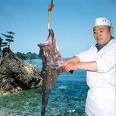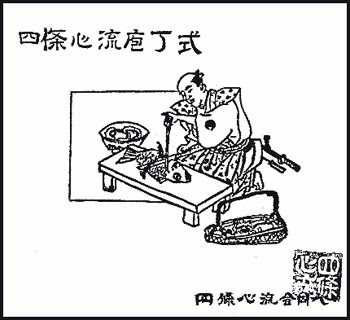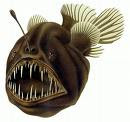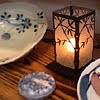::::::::::::::::::::::::::::::::::::::::::::::::::::::::::::::::::::::::::::::::::::::::::::::::::::
Anglerfish, angler fish (ankoo)
***** Location: Japan
***** Season: All winter
***** Category: Animal and Humanity
*****************************
Explanation

ankoo 鮟鱇 (あんこう) anglerfish, goosefish, monkfish
Lophiomus setigerus. "frog fish"
biwagyo 琵琶魚(びわぎょ)"biwa fish" (because its form is like the musical instrument biwa lute.
roobagyo 老婆魚(ろうばぎょ)"fish like an old woman"
kaseigyo, kaseiuo 華臍魚(かせいぎょ)
jugyo 綬魚(じゅぎょ)
The name "anglerfish" derives form the way this fish gets his food. He opens his huge mouth and puts out a bit of the tounge, that is like a bait for smaller fish. When a smaller fish comes for the bait, ankoo closes his own big mouth and swallows the prey in one gulp.
In Japan, two varieties of this fish are eaten.
hon ankoo ホンアンコウ 本鮟鱇. ki ankoo (キアンコウ 黄鮟鱇)
yellow goosefish, Lophius litulon
and
kutsu ankoo クツアンコウ. 苦津鮟鱇 blackmouth goosefish
Lophius setigerus Vahl

ankoo no tsurushigiri 鮟鱇の吊し切り(あんこうのつるしぎり)
cutting an anglerfish while hanging it up
The fish is too soft to be cut on a chopping board.
The fish is hung up on a triangular stand, with a metal hook in his lower jaw, at the beach in winter and cut with a few skillful choppings. The "seven vital parts 鮟鱇の七つ道具" of the fish are chopped off until only the jaw and bones are left.
This is often now used as a tourist attraction in Ibaraki, whith a tasting of the soup right on the beach.
Ankoo has to be prepared quite fast, since otherwise it gets a taste of ammoniak.
I have seen this cutting performance many times on TV, it is a rather exciting, joyful event. One fisher family whithout a son to take over is even training their daughter to perform this cutting.
The fish spawns in november, when it also tastes best.
Here is some KIGO food with ankoo:
ankoonabe, ankoo nabe 鮟鱇鍋 (あんこうなべ)
hodgepodge soup with anko
. . . CLICK here for Photos !
..... ankoojiru 鮟鱇汁(あんこうじる) anko soup
Often spiced with white miso and then the liver is stirred into the soup too.
The skin is also chopped and added. Vegetables like radish, leek, shiitake and then tofu may be added.
ankoo zoosui 鮟鱇雑炊(あんこうぞうすい)
thin rice soup with anko
. . . CLICK here for Photos !
ankoo is a deep sea fish without scales, caught only in the winter months. It looks quite horrifying with its large mouth and many sharp teeth, but the body is quite soft and delicious.
In Japan there is a saying about these two special fish:
the globefish from the south,
the anglerfish from the north
南の河豚、北の鮟鱇
minami no fugu, kita no ankoo
.................................................................................
Local names for this fish in Japan, more than 20
アンコウ 東京都、静岡県、高知県、富山県
アゴ 和歌山県 / キアンコウ 宮城県
アゴウオ 和歌山県 / クツアンコウ 神奈川県
アゴウヲ 和歌山県 / クツアンコオ 神奈川県
アファー 沖縄県 / ゴウオ 和歌山県
アンコ 新潟県、富山県、高知県、和歌山県 / ハタアンゴ 鹿児島県
アンゴ 京都府、和歌山県 / ピーアン 福島県
アンコオ 東京都、静岡県、高知県、富山県 / ピアン 福島県
アンゴウ 大阪府 / ビワキョ
アンコモチ 和歌山県 / ミヅアンコウ 宮城県
エドアンコオ 高知県
カマギョ
hime ankoo 姫鮟鱇(ヒメアンコウ)"princess ankoo"
Lophiodes naresi or Lophiodes moseleyi
and
nodoguro hime ankoo 喉黒姫鮟鱇(ノドグロヒメアンコウ)
"with a black throat"
medama ankoo 目玉鮟鱇(メダマアンコウ)
Bigeye goosefish
mino ankoo 蓑鮟鱇(ミノアンコウ)
Lophiid fimbriatus
shimofuri hana ankoo 霜降花鮟鱇(シモフリハナアンコウ)
Flowery goosefish
:::::::::::::::::::::::::::::::::::::::::::::::::::::::::::::::::::::::::::::::::::::::::::::::::::::
ankoo hoonoo hoochoo shiki 鮟鱇奉納庖丁式
ceremony to cut an ankoo
The fish is cut with the use of a swordlike knife and special metal chopsticks 真魚箸 and the priest is not allowed to touch it with his hands during the performance, so as to keep the food ritually clean before serving it to the deity. The "seven parts" are carefully cut out and arranged on a plate in the form of the big dipper star.

at the shrine Oarai Isozaki Jinja, Ibaraki
茨城県東茨城郡大洗町磯浜町6890 . 大洗磯前神社
The shrine was founded in 856 A.D., the main hall of the shrine was destroyed in a fire 400 years ago. It was later reconstructed by the lord Tokugawa Mitsukuni in 1690. The main gate is 16 meters high and has a splendid first impression.
. . . CLICK here for Photos of the shrine !
They hold lessons for cooks to learn this special ritual way of cutting ankoo and other fish in the old, ceremonial way.
. WASHOKU
the "Way of the Kitchen Knife"
.................................................................................
The Seven Parts of an ankoo
鮟鱇の七つ道具
(actually, they are eight)
liver 「肝」, ovaries「ぬの(卵巣)」, fins「ひれ」, gills「えら」, stomach「水ぶくろ(胃), skin 」「皮」
and
"willow" meat from the jaws 「柳(頬の身)」
"big body" meat from the tail fin「大身(尾の部分)」
These two parts are the real "meat" of the fish and therefore taken as just one item.
These are all taken out and used for the soup.
The "water sack" stomach is slightly boiled and marinated with vinegar.
"nanatsu doogu, the seven tools"
is an expression mostly for craftsmen, when all necessary tools are together for work. It was also used for a samurai when all his necessary equipment, like sword, bow and arrow, helmet and suit of armor was put together.
In the Muromachi period, this was called "nanatsu mono 七つ物, the seven things".
external LINK with great photos of these parts
http://www.zukan-bouz.com/fish/ankou/kiankou.html
:::::::::::::::::::::::::::::::::::::::::::::::::::::::::::::::::::::::::::::::::::::::::::::::::::

Anglerfish are the members of the order Lophiiformes.
They are bony fish named for their characteristic mode of predation, wherein a fleshy growth from the fish's head (the esca or illicium) acts as a lure; this is considered analogous to angling.
Some anglerfish are pelagic (live in the open water), while others are benthic (bottom-dwelling). Some live in the deep sea (e.g. Ceratiidae) and others on the continental shelf (e.g. the frogfishes Antennariidae and the monkfish/goosefish Lophiidae). They occur worldwide. Pelagic forms are most laterally (sideways) compressed whereas the benthic forms are often extremely dorsoventrally compressed (depressed) often with large upward pointing mouths.
One family Lophiidae is of commercial interest with fisheries found in the in north-western Europe, eastern North America, Africa and the Far East. In Europe and North America, the tail meat of fish of the genus Lophius (known as goosefish (North America) or monkfish), is widely used in cooking and is often compared to lobster tail in taste and texture. In Asia, especially Korea and Japan, it is a delicacy.
© More in the WIKIPEDIA !
:::::::::::::::::::::::::::::::::::::::::::::::::::::::::::::::::::::::::::::::::::::::::::::::::::::
not kigo
ankimo あんきも / あん肝 . あんぎも liver of the anko
This is quite a large part of the fish. It is steamed, a speciality when drinking sake.
Ankimo, the "foie gras" of seafood. 海のフォアグラ
It tasts good with a bit of ponzu sauce and grated radish.
. . . CLICK here for Photos !
:::::::::::::::::::::::::::::::::::::::::::::::::::::::::::::::::::::::::::::::::::::::::::::::::::::
アンコウ
choochin ankoo 提灯鮟鱇 "lantern angler fish"
Himantolophus groenlandicus
Atlantic footballfish, football fish
ankoo no choochin アンコウの提灯(ちょうちん)
. . . CLICK here for Photos !
.................................................................................
some combinations with ANKOO
ankoogata あんこがた【鮟鱇形】あんこうがた "form of an ankoo"
Said for a very fat sumo ringer who walks with his huge stomach protruding.
ankoomusha, ankoo musha 鮟鱇武者 "Anko Samurai"
ankoozamurai 鮟鱇侍(あんごうざむらい)
One who is bragging a lot but does not live up to his stories.
ankoo no emachi あんこうのえまち【鮟鱇の餌待ち】
"waiting for pray" like an ankoo
A lazy person who stands around with his mouth wide open.
A day laborer who is waiting for a job.
also called
tachinboo たちんぼう【立ちん坊】 "just standing around"
ankoo no tsu ni museta yoo na hito
鱇の唾に噎せたような人 (あんこうのつにむせたようなひと)
standing around with an open mouth like an ankoo
ankoo no machi-gui 鮟鱇の待ち食い(あんこうのまちぐい)
waiting for food "like an ankoo"
and eating only what is placed in front of you.
Also someone who does not give anything but waits for others to give him some food.
:::::::::::::::::::::::::::::::::::::::::::::::::::::::::::::::::::::::::::::::::::::::::::::::::::::
Ibaraki prefecture
ankoonabe, ankoo nabe 鮟鱇鍋 (あんこうなべ)
hodgepodge soup with anko
see above.
あんこうのとも酢 ankoo with vinegar
The liver is boiled with sugar, miso and vinegar.
tomosu ae とも酢和え marinated with vinegar
. . . CLICK here for Photos !
dobujiru どぶ汁 soup with ankoo meat of all parts
First the liver is put in a cast-iron pot, then all the other parts too and simmered without much added water. It has a rather strong taste.
. . . CLICK here for Photos !
ankoo no kara-age 鮟鱇 唐揚げ / アンコウ唐揚
deep-fried anko pieces
. . . CLICK here for Photos !
ankoo no honezake, hone sake 鮟鱇の骨酒
bones of ankoo immersed in ricewine
A popular way of drinking with the bones of fish.
. WASHOKU
Ibaraki prefecture (Ibaragi)
*****************************
Worldwide use
Der Seeteufel (ankoo, "devil of the sea")
ist eine Spezialität von Nord-Ibaraki.
Er wird in einem Dreiecksgestell aufgehängt und am Strand mit wenigen Messerschnitten ausgenommen – eine Attraktion für die Touristen in den Wintermonaten. Die Seeteufel-Leber in einem heißen Eintopf ist eine kulinarische Delikatesse, aber auch eine Suppe aus anderen Seeteufel-Teilen (dobujiru ) wärmt nicht nur angenehm den Körper in der kalten Jahreszeit, sondern schmeckt auch vorzüglich.
ankoo nabe ... Seeteufel-Eintopf
:::::::::::::::::::::::::::::::::::::::::::::::::::::::::::::::::::::::::::::::::::::::::::::::::::::
Monkfish (or headfish)
is the English name of a number of types of fish in the northwest Atlantic, most notably the species of the anglerfish genus Lophius and the angelshark genus Squatina. The term is also occasionally used for a European sea monster more often called a sea monk.
Monkfish is the most common English name for the genus Lophius in the northeast Atlantic but goosefish is used as the equivalent term on the eastern coast of North America.

© More in the WIKIPEDIA !
*****************************
Things found on the way
*****************************
HAIKU and SENRYU

あんかうに一膳めしの行灯哉
ankoo ni ichizen meshi no andon kana
one dish
with anglerfish and rice
and one shaded lamp . . .
The cut marker KANA is at the end of line 3.
. Masaoka Shiki 正岡子規 .
Andon, choochin
Japanese Lanterns and Lamps
:::::::::::::::::::::::::::::::::::::::::::::::::::::::::::::::::::::::::::::::::::::::::::::::::::::

鮟鱇の骨まで凍ててぶちきらる
ankoo no hone made itete buchi-kiraru
ankō-no hone-made itete buchikiraru
this angler fish
feeing chilled to the bone
is (finally) cut to pieces
Kato Shuson 加藤楸邨 Katoo Shuuson
We can imagine the author in 1949 just after the war, he himself just recovering from an illness, at the cold beach in the cold winter wind, he himself frozen to the bone.
Or he was lying ill in his bed, just thinking of a scene he had observed earlier in his life.
Kato, Shuson Kato (1905-1993)
This haiku has caused many speculations about its "real" meaning.
Here are some questions that have come up.
Japanese Reference
Was the fish really frozen to the bone and put on a chopping bord to be cut with a large butcher knife used to cut frozen meat?
Were only the bones then "hacked (buchi-kiru)" by the knife?
(butsugiri is a verb used for cutting meat or fish into smaller pieces, as opposed to cutting slices for sashimi and sushi.)
The first line in normal grammar would read "ankoo ga ... "
The saijiki tells us that the use of the passive verb form "buchikiraru" implies a kind of pitifull compassion and pain with the fate of the fish (mono no aware). The author feels like the fish itself.
The choice of the verb ITEru, feeling chilled or freezing, and not KOORU (used for frozen food) also gives this a human touch.
Hacking the whole frozen fish to pieces would be a very uncommon way of slaughtering this kind of fish with its hard bones and very soft meat, and where would the poet have to be to watch such a situation?
Maybe at the shop window of a fishmonger?
Ankoo is too big to put into the home freezer of a fisherman.
So was this observed at some fish market?
Do they offer frozen ankoo bones for sale?
or
Was the fish prepared in the normal way as hanging on the beach and cut into pieces in the fashion of tsurushigiri? And after the fish had been cut in the normal way and the bones frozen in the breeze on the beach, they are now cut on a chopping board? Is this the "last scene" of the tsurushigiri cutting performance?
(This seems the most common interpretation of this haiku.)
Or is this related the use of the figure of speech for a cold day outside, when a human watches the scene of the fish soup preparation, and a kind of personification of how the poor fish must feel cold also?
kooru hodo no samusa 凍るほど寒?
Is this a haiku-rendered description of the post-war situation of Japan after Hiroshima and Nagasaki?
(Some modern HP even quote it with respect to the situation of the much debated Yamba Dam Project in 2009.)
The Yamba dam project
More questions then answers.
This haiku does not simply describe a dead frozen fish straight from the refrigerator, like a salmon, taken out and violently hacked to pieces.
Through the choice of the ANKOO, which plays a special role in Japanese food culture through the way it needs to be processed, it gives the whole scene on the beach a "human" touch.
I want to express this in my translation.
. thoughts on : Beauty, Tao and Haiku
:::::::::::::::::::::::::::::::::::::::::::::::::::::::::::::::::::::::::::::::::::::::::::::::::::::
鮟鱇の外の吹雪を忘れさせ
ankoo no soto no fubuki o wasuresase
this anglerfish
lets me forget about
the blizzard outside
Nakamura Raionboo 中村 雷音坊
:::::::::::::::::::::::::::::::::::::::::::::::::::::::::::::::::::::::::::::::::::::::::::::::::::::
There is also an anonymous senryu about the Chinese character for this fish
鮟 . . . 魚 安
魚偏に安いと書く春のこと
uohen ni yasui to kaite haru no koto
fish radical on the left side
cheap on the right side ...
this is spring
when the fish does not taste good any more in spring and is not eaten any longer.
:::::::::::::::::::::::::::::::::::::::::::::::::::::::::::::::::::::::::::::::::::::::::::::::::::::
more haiku with anko
鮟鱇の 愚にして 咎(トガ)は なかりけり 村上鬼城
鮟鱇の 口ばかりなり 流しもと 高浜虚子
とめどなき 大鮟鱇の 涎かな 岡田耿陽
鮟鱇の 泣寝入りして 買はれけり 堀口星眠
ankoonabe
鮟鱇鍋 河豚の苦説も なかりけり 正岡子規
鮟鱇の 肝 うかみ出し 鮟鱇鍋 高浜虚子
ほかの部屋 大いに笑ふ 鮟鱇鍋 深川正一郎
鮟鱇鍋 酔の壮語を 盾として 小林康治
ひとりごち ひとり荒べる 鮟鱇鍋 森澄雄
鮟鱇鍋 箸もぐらぐら 煮ゆるなり 高浜虚子
友と居て 妻を疎んず 鮟鱇鍋 高橋沐石
水原秋櫻子・加藤楸邨・山本健吉:日本大歳時記
(講談社、1996)
鮟鱇を ふりさけ見れば 厨かな 其角
鮟鱇のさかさまに 目は蘭けにけり 護物
鮟鱇や かげ膳 据えて 猪口 一つ 飯田蛇笏
鮟鱇も わが身の業も 煮ゆるかな 久保田万太郎
舟釣瓶 ぶっかけられし 鮟鱇かな 阿波野青畝
鮟鱇を吊し 魚屋 夕景色 山口青邨
とめどなき 大鮟鱇の 涎かな 岡田耿陽
鮟鱇や 店に生きゐて 日暮れなる 中川宋淵
鮟鱇を剥くに 鎮めの水を打つ 菅裸馬
身を削がれゆき 鮟鱇の眼ありけり 牧野蓼蓼
鮟鱇の吊し切とは いたましや 鈴木真砂女
イエスより軽く 鮟鱇を吊りさげる 有馬朗人
鮟鱇の泣寝入りして 買はれけり 堀口星眠
人中に鮟鱇 吊られ したたれり 小林康治
鮟鱇の子といふものを 喰はされぬ 星野麦丘人
肛門を見せて 鮟鱇 ならびけり 森田峠
吊るされて 夜の 鮟鱇 ただよへり 伊藤通明
鮟鱇の吊るされてゐて 笑いけり 飯山修
凍てきれずあり 鮟鱇の いびつ顔 田中敦子
鮟鱇のよだれの先の凍てにけり 小田実希次
source : www.ami-yacon.jp
*****************************
Related words
Blowfish (fugu) Japan. .. Puffer fish, Globefish, Swellfish
***** WASHOKU : Regional Japanese Dishes
***** WASHOKU : FISH and SEAFOOD SAIJIKI
***** . Biwa 琵琶 lute .
[ . BACK to WORLDKIGO . TOP . ]
:::::::::::::::::::::::::::::::::::::::::::::::::::::::::::::::::::::::::::::::::::::::::::::::::::::




1 comment:
the anglerfish frozen
right down to its very bones
is hacked to pieces
—Katō Shūson (1905–1993)
(translated by Dhugal J. Lindsay)
This poem may startle readers because of its bluntness and violence.
Many readers and writers of haiku prefer that haiku focus on the beautiful, so much so that they may believe that haiku should be limited to the beautiful.
more about
Beauty in Haiku
By Michael Dylan Welch
http://www.thehaikufoundation.org/2010/02/10/viral-5-6/
Post a Comment